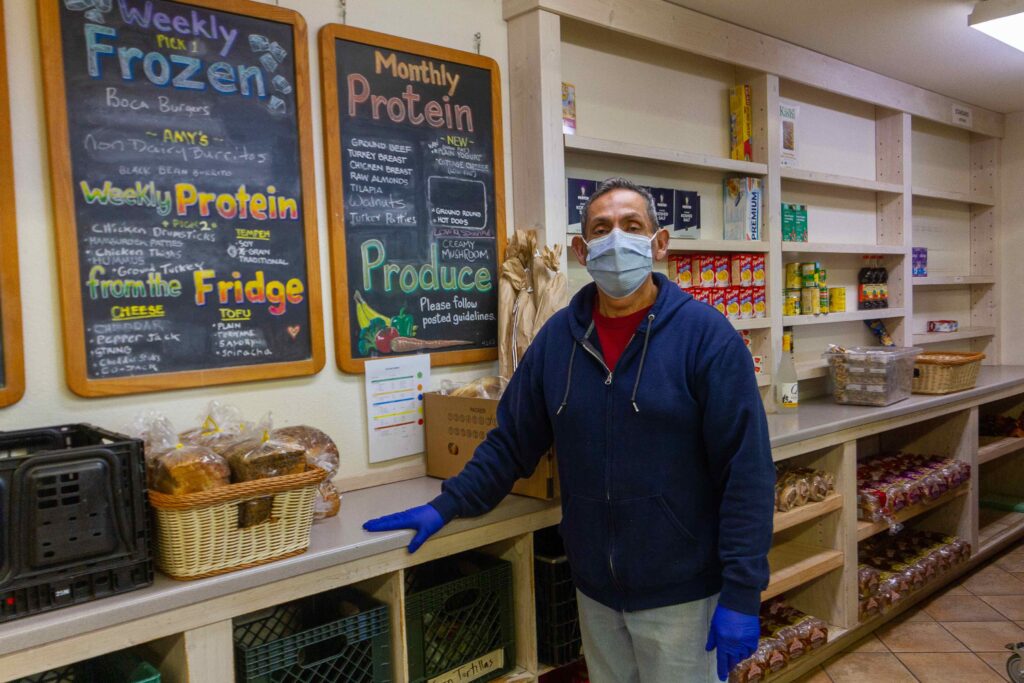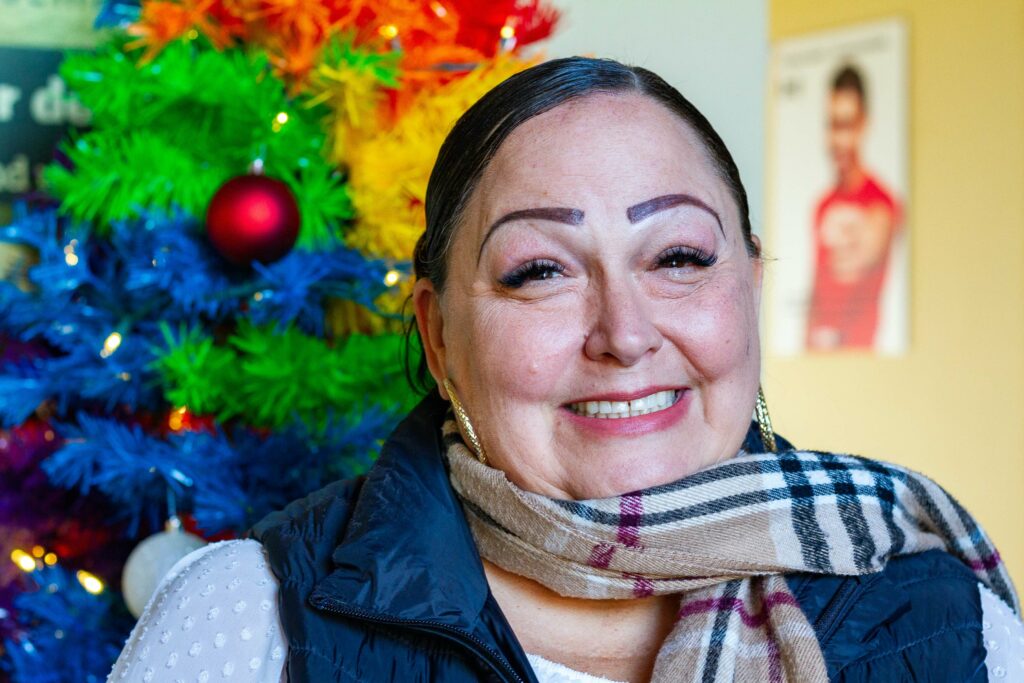“In the beginning, we had to pull every resource together in order to take care of each other,” says Ray Tilton, 58, who has been living with HIV for almost 40 years.
“People aren’t dying like they used to, because of the medications available and the population of HIV/AIDS people doesn’t grow as fast as it used to,” he says. “Those are good things, but I think HIV/AIDS gets pushed back on the backburner so far that [people living with it] are almost an unseen minority, when our issues and concerns and problems still exist.”
Dec. 1 is World AIDS Day. Observed since 1988 as an official global health campaign by the World Health Organization, it is a day for raising awareness about HIV/AIDS prevention and treatment, as well as for mourning those who died because of the disease. This year, the U.S. theme of World AIDS Day is “End inequalities. End AIDS.”
While today HIV/AIDS is highly treatable, and new cases in Sonoma County are a fraction of what they were in the 1980s and ’90s, stopping the spread of infection necessitates addressing inequalities in our social fabric. The illness—which is most commonly spread through sexual contact between men and intravenous drug use—disproportionately impacts populations that mainstream society stigmatizes.
The Bohemian spoke to local AIDS service organizations, healthcare workers and individuals living with HIV to learn about the history of AIDS activism in Sonoma County and the challenges the area faces in the prevention and treatment of HIV/AIDS today.
According to the most recent annual report, Sonoma County had 1,358 confirmed cases in 2017. A national estimate that 15% of people living with HIV don’t know that they are infected suggests that there are likely more than 1,600 HIV+ people in the county.
The social movement for gay liberation began to gain traction about a decade before HIV was first diagnosed, and then proceeded alongside AIDS activism for several decades. Although there is greater social acceptance of cisgender gay people today—especially in white populations—societal stigma remains high for transgender women, queer people of color, injection drug users, sex workers and unhoused people. In these populations, HIV/AIDS infection rates aren’t declining at the pace they have among cisgender white men who have sex with men.
Dr. Ele Lozares-Lewis, an HIV specialist at Santa Rosa Community Health, says that a combination of fires, a newer pandemic and the survivability of HIV all mean that the disease is less talked about than it was at its peak.
“I worry that the attention on HIV/AIDS has kind of fallen by the wayside, and we have so much work to do,” she says.

In the Beginning
Sonoma County’s first diagnosed HIV case was 40 years ago. By 1987, Sonoma County had the third-highest per-capita rate of infection in California, with 31.2 cases for every 100,000 people. The prevalence of AIDS in the area can be attributed to Sonoma County’s proximity to San Francisco and to Guerneville being a popular gay and lesbian travel destination and home. At that time, San Francisco’s infection rate was more than 10 times higher than anywhere else in the state, with 4% of the total population, and nearly 50% of the estimated population of gay men, facing the illness at the time, according to a 1988 LA Times article.
For the first eight years of the AIDS epidemic in Sonoma County, AIDS service organizations did not receive federal funding, so much of the care for people dying of the illness fell on volunteers, many of whom who were already gay- and lesbian-liberation activists.
Two of Sonoma County’s earliest AIDS service organizations were Face to Face (est. 1983), and Food for Thought (est. 1988).
“The volunteers who advocated for Face to Face clients performed critical services that included, domestic assistance, communication with friends and relatives, and providing personal care. This care often involved kindnesses outside of transportation to doctor’s appointments and meal preparation,” writes Kate Todd in her thesis, Sonoma County’s Responses to the AIDS Epidemic, 1981-1997.
Activists, who saw that many AIDS patients were not getting enough food, founded Food for Thought Food Bank. Additionally, HIV wasting syndrome—which is characterized by involuntary weight- and muscle-loss—was a common effect of the illness.
Ron Karp, executive director of Food for Thought, says “At first, people were dying quickly. By 1996, the [treatment] drugs became so effective that people almost abruptly stopped dying. Around that time, the death rate [in Sonoma County] went from around 100 people per year down to maybe 5, which is just remarkable.”
As this change occurred, the nature of the work at Face to Face and Food for Thought shifted from end-of-life care to ongoing support of people who were now expected to live with HIV/AIDS.

The Resources Today
Face to Face Executive Director Sara Brewer says, “In 2021, we provided 452 HIV tests, enrolled 18 people onto [the preventative drug] PrEP, housed 15 clients and housed 9 clients in temporary hotels.” They also provided 182 clients with financial assistance, case management, and legal and medical advocacy.
“Stable housing is a huge part of your mental, emotional and physical stability,” says Tilton, who lives in a Section 8 apartment in Santa Rosa.
Lorie Violette is the director of prevention at Face to Face. Her work is rooted in the principles of harm reduction. With regards to substance use, she says “Harm reduction is about showing love, compassion and dignity to people who use drugs, without judgement, and providing them with safer ways to use substances as well as ways to get into resources in the community.”
She continues, “We know people can make changes when they feel love, support and connection. We are here to provide all of that, and very much keep it real with risks that people may be engaging in.”
Along with providing HIV testing and safer-sex barriers like condoms and enrollment on PrEP, Face to Face provides syringes—and a no-contact retrieval box for used needles, smoking implements and Naloxone kits to reverse opiate overdoses.
In 2014, after many years witnessing the positive effect consistent nutrition has on people living long-term with HIV, Food for Thought expanded their mission to provide groceries and medically-tailored meals to people living with other illnesses. A combination of staff and volunteers prepare orders and often deliver groceries and meals to people living with serious medical conditions in Sonoma County. In 2020, the organization served 6,500 people, of which about 400 live with HIV.
Nina Redman, client services director at Food for Thought, says, “The rates in our county of people [with HIV] who are in care, stay in care and sustain a suppressed viral load are really good. They’re some of the best in the country. And I think a lot of that has to do with the fact that we have really good services here.”
Despite a relative abundance of services, Tilton says, “There’s a huge older HIV/AIDS community in this county, I know that, but sometimes I’m like, ‘Where have we all gone?’ The isolation—especially during Covid—has just been crushing.”
He also points to economic disparity exacerbating loneliness and taking a toll on his self esteem.
“[When I was younger] I was always contributing, always doing things in the community, so I always had that sense of value. Now, as I’m aging, when I think about [going out and socializing], I sometimes think, ‘I have AIDS, I’m older, I have Section 8, you know—what do I have to offer?’ I don’t like that those things are becoming a little more prevalent in my thought process,” Tilton says.
In 2017, there were 30 new cases diagnosed in Sonoma County, of which 10% were not diagnosed until the virus had progressed from HIV to AIDS. That said, treatment is so effective now that even people diagnosed with advanced AIDS can reduce their viral load to an undetectable level, at which point the illness cannot be transmitted sexually. This process can take as little as three months.
Santa Rosa Community Health’s VISTA Clinic treats 550 of the people diagnosed with HIV/AIDS in Sonoma County. Dr. Lozares-Lewis says, “[At SRCH], we’ll do a rapid start where someone can get their diagnosis and get started on treatment, sometimes that day. And then, we also have a HIV psychologist, so we get to connect people to mental health services and support groups.”
While effective treatment has existed since the mid-1990s, it has improved a lot since then.
Lozares-Lewis says, “I had a patient once who just cried when she saw what current treatments are, because she used to have to take handfuls of pills and some with food, some without, three times a day—and they all made her sick … . Now there are full regiments for treating HIV that are taken in one pill, once a day, with little-to-no side effects for most patients.”
Newer still, Lozares-Lewis says SRCH also offers once-monthly injectable treatment. Injectable PrEP is forthcoming, too. She is hopeful that this will increase access to preventative measures. “When someone [who is afraid of being outed] can come in and get a shot, they don’t have to worry about being found with a bottle of pills,” she says.
Lozares-Lewis says that, around 2008, new case rates dropped among white men who have sex with men, but transmission rates have held steady or increased since then in the Latinx population. “Most of the new diagnoses we’re getting are in the Roseland area … among migrant communities and the Latinx population, there can be such a huge amount of stigma and some challenges with accessing care that really need to be addressed.”











